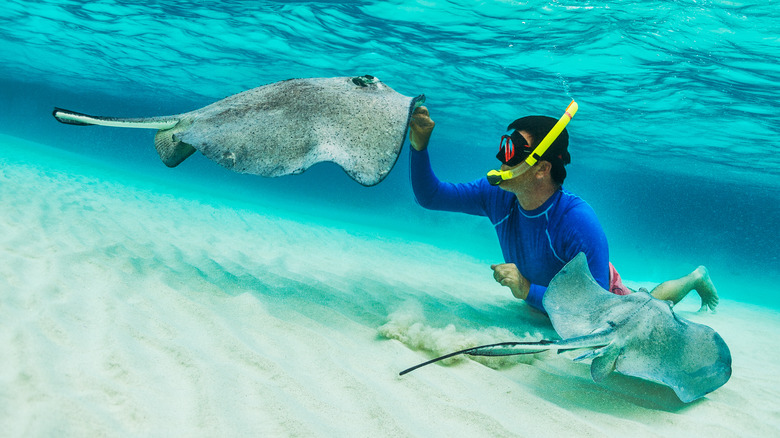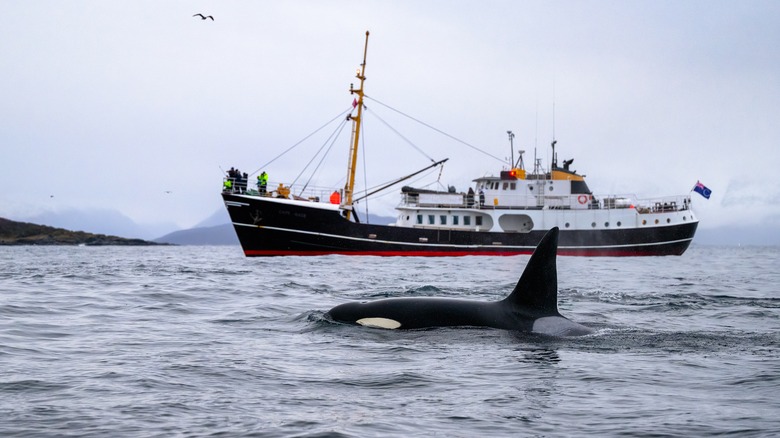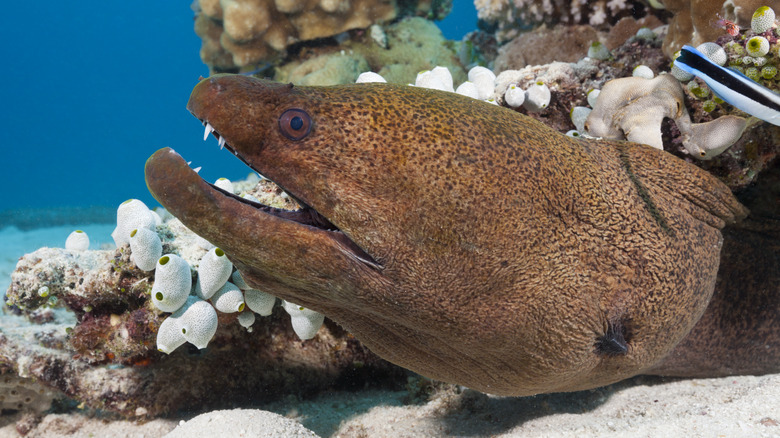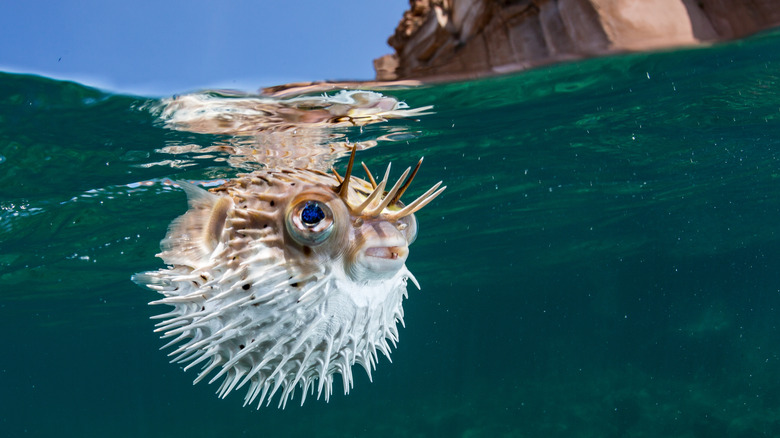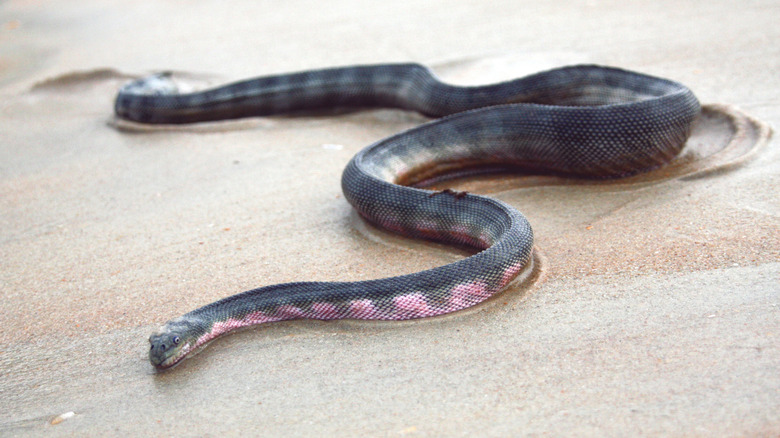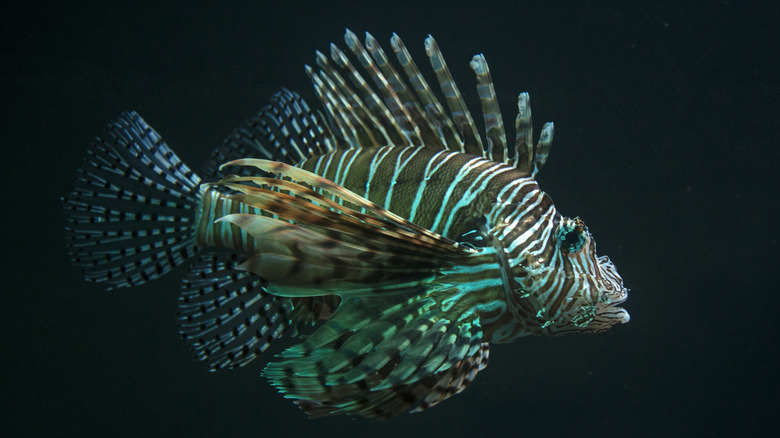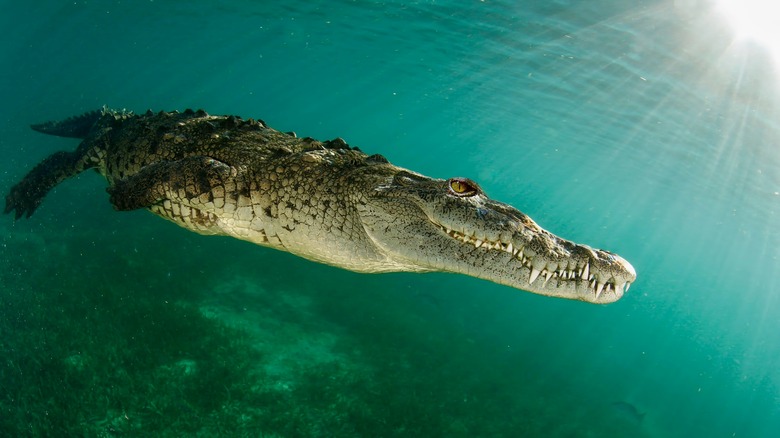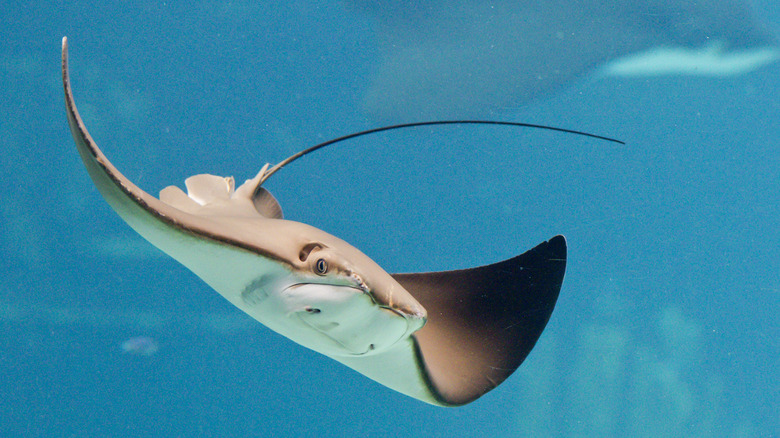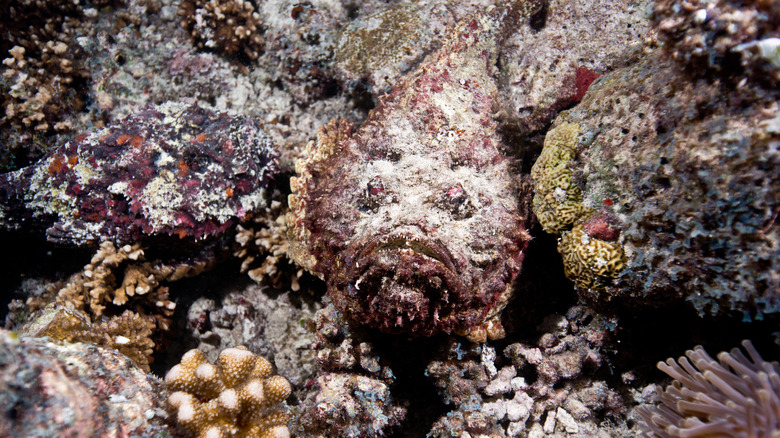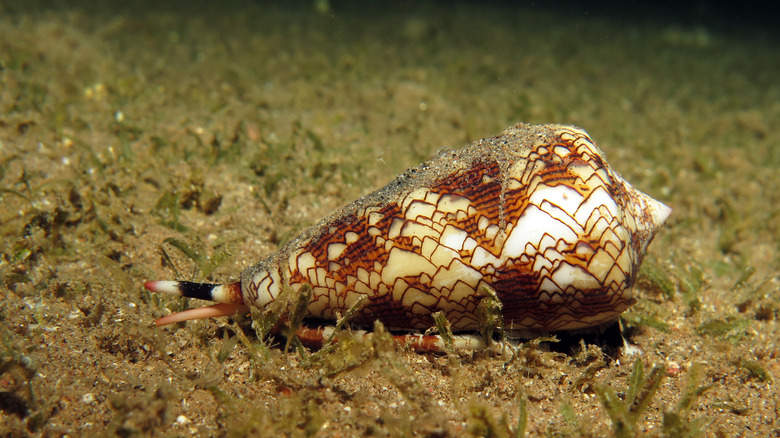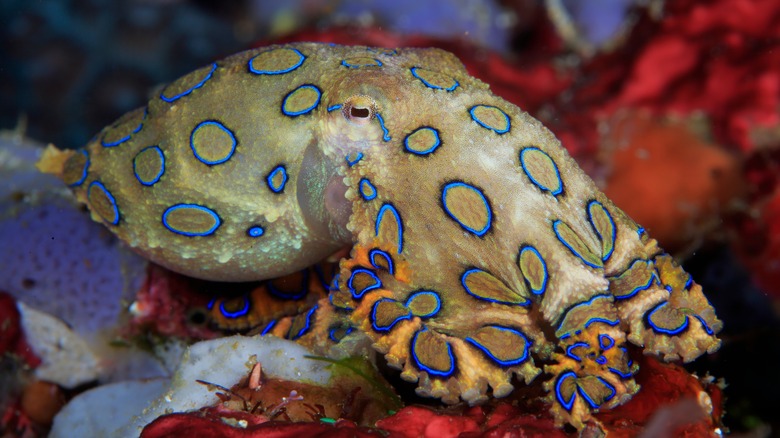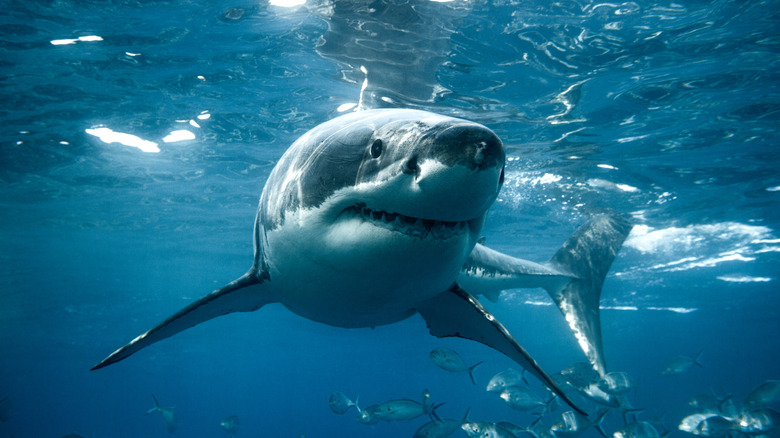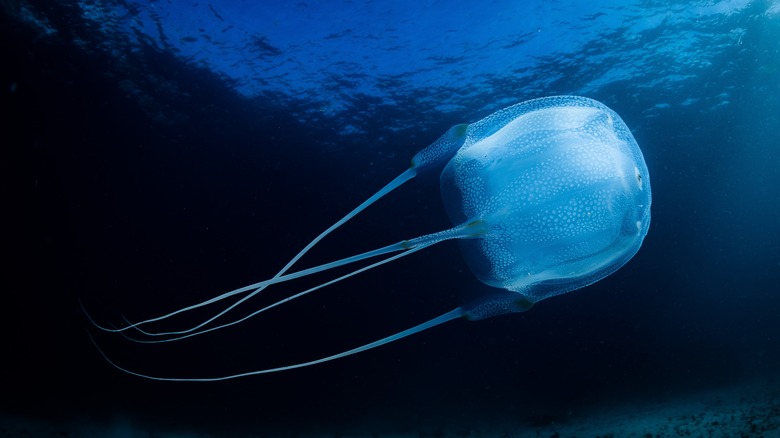Nature's Deadliest Ocean Creatures You Don't Want To Mess With
The ocean is an unpredictable and dangerous place. Storms can whip up the surf into a frenzy, swallowing ships and flooding coastal towns. Rip currents can carry away swimmers, and red tide can bring harmful bacteria to shore. Yet, perhaps more threatening than the ocean itself are the creatures that live within it.
No matter where you go on the globe, there are animals that can cause you harm. Nowhere is this more true than in the ocean. The earth's great bodies of water are home to some of the deadliest animals on the planet. There are creatures to beware of no matter where you swim. Whether through size and strength or cunning and venom, there are just some ocean creatures that you do not want to mess with.
To prove this point, we've assembled a list of what we at Outdoor Guide believe are the 12 deadliest creatures swimming through the oceans. Some of these creatures won't use their natural weapons unless they absolutely have to. Others will attack at random. So consider this a warning, and proceed ahead with caution.
Orca whales go after boats
While we all wax nostalgic for the friendly orca in the "Free Willy" franchise, the fact of the matter is that killer whales tend to live up to their names. While they will not necessarily go after solo swimmers or divers, orca whales have been known to go after, and sink, recreational boats. Needless to say, this can put sailors in a bit of a predicament.
Now, there is a case to be made that the orca whales are simply playing. Whether they are or not, the behavior has dangerous ramifications on people. According to Outside Magazine, the coastal waters along the Iberian Peninsula (Spain and Portugal) are colloquially called "Orca Alley." Over 600 ships have been hit by the whales, and five have been sunk within the last few years. This poses a dangerous threat to those looking to sail between the Atlantic and Mediterranean.
Owing to their immense intelligence, orcas have been seen teaching each other how to attack and sink certain ships. This is why attacks on boats are set to increase over the next few years, according to experts interviewed by Live Science. If you're sailing the Straits of Gibraltar anytime soon, be warned your vessel could be sunk by an orca whale.
Moray eels have powerful jaws
I'd like to momentarily interject to share an anecdote about how dangerous moray eels are. In his youth, my father was a certified dive master and dived all over the USA and Caribbean. In a coral reef, a moray eel suddenly burst forth from a crevice and sunk its teeth into my dad's right arm. Fortunately, he was wearing a thick-lined wetsuit, so the eels bite didn't penetrate. He also had a knife on him, which he used to pry the eel loose from his suit and ward it away with a few jabs.
Anecdotes aside, moray eels are incredibly dangerous animals. They could easily tear through a normal wetsuit with their razor sharp teeth. Depending where on your body they bite, you could end up with significant injuries, or even be killed.
Unlike orcas and some of the other animals on this list, moray eels are incredibly aggressive and will attack without warning. This is often due to territoriality. Going back to my dad's story, he likely came across the eel's lair, and the eel attacked due to it feeling threatened. The fact that they love to hide in the crevices of coral reefs doesn't make it any easier to know where they will and won't be. Divers would do well to wear thicker wetsuits and bring a knife when diving in known eel habitats.
Pufferfish are 1,200 times more poisonous than cyanide
While they may look innocent enough on the outside, the pufferfish is anything but. Their docile appearance is part of their defense mechanism. When they feel threatened, the pufferfish will inflate themselves to twice their normal size and become an inedible, spiked ball as a defense against predators. Pufferfish do not reveal their poisonous spines until they are fully inflated. Marine animals and swimmers would do well to avoid these fish, whether they are in defense mode or not.
A toxin called tetrodotoxin is found within a pufferfish liver and secreted on its skin. If this toxin is passed along to you via a cut by one of the pufferfish's spiky spines, you are done for. This is because tetrodotoxin is 1,200 more potent than cyanide. A single pufferfish has within it enough tetrodotoxin to kill 30 human adults.
So, if a predator comes across and manages to eat one of these fish, the pufferfish will have the last laugh. Humans, however, seem to be more daring. In Japan, pufferfish sashimi is considered a delicacy. Only certified chefs are allowed to prepare and serve it. It's a tough job, considering that if they get it wrong, customers die. The Natural History Museum reports that pufferfish poisoning is the leading cause of fatal food poisoning in Japan.
The venom of a beaked sea snake is potent
It's a well known fact that some of the deadliest creatures on earth live in the lands and waters of Australia. Many of those deadly creatures happen to be snakes, with the sea snakes proving to be among the most dangerous of them all. One of these deadly aquatic reptiles is the beaked sea snake. Though it is not outwardly aggressive towards swimmers, if you get on the wrong side of this snake, it's bad news for you.
The Marine Education Society of Australia states that "just 1.5 milligrams of its venom, rated four to eight times as toxic as cobra venom, can cause death to humans." That is an incredibly potent venom. And considering that a good bite from a beaked sea snake can inject far more than 1.5 milligrams depending on its length, a bitten person could be looking at a very fast, very painful death.
Now, the beaked sea snakes territory is not limited to the coast of Australia. The entire Indo-Pacific is home to these deadly snakes. Fortunately, their skittish disposition means that they are not likely to come across you. Just know that if you see one, it's best to leave it alone and swim in the opposite direction.
Watch out for the sharp spine of the lionfish
One of the great ironies of nature is that sea creatures who bear similar names to land-dwelling mamals seldom live up to the majestic looks of their air-breathing namesakes. Such is the case with the lionfish. Arguably one of the strangest looking fish in the entire world, the lionfish is an amalgamation of colorful stripes, long, spindly fins, and a squashed face that would put an orc from "Lord of the Rings" to shame. However, despite these fierce looks, the lionfish causes far more harm to commercial fishing operations than they do to swimmers.
Though they are native to the Indo-Pacific, lionfish have become increasingly common in the Atlantic. Since they are carnivores and feast on smaller fish and crustaceans, they have greatly affected Atlantic ecosystems and commercial fishing species.
However, should you come across one while diving or snorkeling, beware of their extended spines. They are incredibly sharp and filled with a potent venom that can cause severe pain. According to Poison Control, deaths from lionfish stings are very rare. However, symptoms from the sting can sometimes last up to a month depending on how badly you were stung.
The saltwater crocodile is the largest reptile on earth
With an average length of 17 feet long and an average weight of 1,000 pounds, the saltwater crocodiles hold the title of the largest reptile on planet earth. You can seldom believe you're looking at something that large, something that has been on earth since the time of the dinosaurs. These beasts thrive in warmer waters and do not take kindly to strangers. In fact, one of the reasons they are so aggressive is because they are very territorial.
Regardless of what crocodile-infested waters you find yourself in, you need to be aware of your surroundings. Though they are utterly enormous, they prefer lurking in murky coastal waters and mangrove forests where their camouflage will come in handy. Wandering through their area is going to leave you the worse for wear, as saltwater crocs are responsible for several dozen attacks on people every year.
Much depends on the severity of the attack, but even a small nip could leave you in shreds. Known to have one of the strongest bites in the animal kingdom, the saltwater crocodile can very easily tear apart a person if it felt so inclined. One of their favorite things to hunt is wild boars. Considering these huge pigs are incredibly dangerous on land, the ease with which they can be taken down by a saltwater crocodile should be sobering for anyone.
Beware the tail of the stingray
Though they are not at all aggressive towards people, the fact remains that stingrays present a danger to those who come across it. While the majority of encounters are not deadly, stingrays are still responsible for between 1,500 to 2,000 human injuries every year. These are mostly due to the fact that stingrays like to lie low and bury themselves in the sand, making them nearly impossible to see. Their spiked spinal blades are sharp and will easily pierce skin. However, the thing you need to watch out for the most is their barbed tail.
You really need to startle or tick off a stingray in order for it to unleash its barb on you. A severe wound would be one in which the stinger has pierced your skin. If you get stung, what you should do is leave it alone and wait for medical assistance.
An attack like this was responsible for the 2006 death of "The Crocodile Hunter" himself, Steve Irwin. In Irwin's case, the stinger lodged itself in his chest, causing him to bleed out while underwater. So, though it is extremely rare for a stingray to do so, it is not out of the realm of possibility for one to attack and kill a human being.
A stonefish will see you before you see them
Much like the stingray in that they are practically impossible to see when hiding, the stonefish presents a far less graceful appearance than the majestic stingray. Another fish with a squashed, pout-like face, the stonefish is a large reef dweller that likes to hide among the coral and wait for unknowing prey to swim by. Covered in warts and muddy scales, the stonefish has no problem disappearing into its environment. This is not the best news for snorkelers or divers, because the stonefish also happens to be one of the most venomous fish in the world.
The ease with which one can be punctured by one of the stonefish's spiked dorsal fins is likely owing to the fact that they just look like another rock. The potent venom is injected through the wound and attacks the cardiovascular system. Stonefish venom has been the cause of death for many Pacific Islanders, according to the Australian Museum. However, thanks to an anti-venom developed in 1959, deaths from stonefish stings are far rarer than they once were.
This is why it is worthwhile for everyone who intends to go swimming in the ocean to wear thick-soled swim shoes. As can be plainly seen, they'll be able to protect you from a lot more than an angry crab.
The venom of a cone snail can paralyze swimmers
Though they may look totally innocent, laying there on the seafloor among the other shells, the cone snail happens to be one of the most dangerous creatures in the ocean. Much like the pufferfish, the fact that the cone snail does not look immediately dangerous is actually part of its defense mechanism. When it feels threatened, the snail releases its single, long, incredibly sharp tooth that rapidly injects venom into its prey, which is usually small fish.
However, if a human happens to be tempted to pick up or accidentally steps on a cone snail, they could find themselves on the receiving end of that sting. Though it does not feel much more painful than a bee sting, the amount of venom injected could have some pretty serious effects. And since the cone snail, as a species, has several different types of venom, developing an antidote is tricky.
The toxin will go after the nervous system. At its most minimal, it will cause tingling and mild inflammatory reactions. At its most intense, the venom can cause paralysis, which could in turn cause respiratory failure and even death. So, while you might be tempted to reach out and touch their colorful shells, err on the side of caution and don't do it.
Blue ringed octopi are colorful, but deadly
There are numerous small and cuddly-looking creatures that you should not underestimate when it comes to their danger levels. While the octopus might not be to everyone's taste, there is a certain subset of people who find them utterly adorable and fascinating. The blue ringed octopus is a minuscule creature covered in bright blue rings. It's not much larger than a human hand, usually measuring somewhere from 4 to 6 centimeters in length. However, once again, it packs a deadly punch.
The blue pattern on the octopus comes as a warning. The same way poison dart frogs show off their deadliness with their vibrant colors, the blue ringed octopus will only reveal its rings when it is ready to cause some damage. Their salivary glands produce the same type of tetrodotoxin as the pufferfish. The octopus passes it along through a painless bite, making it incredibly dangerous, as you may not know that it has bitten you.
If the tetrodotoxin is injected into your bloodstream, it can very quickly cause paralysis and cause a complete breakdown of the nervous and respiratory systems. If that occurs, your chances of survival are extremely minimal. Several deaths have occurred as the result of a blue ringed octopus bite.
There's a reason 'Jaws' was a great white
Yes, we went there. While there are numerous different types of dangerous sharks in the world, there are none that strike more fear into the hearts of divers and swimmers than the great white shark. "Jaws" certainly took lots of liberties when it came to the actual behavior of these animals, but the fact that a nearly 50 year old movie continues to scare audiences off of going swimming says something about how terrifying people think sharks are. And while the great white is not intentionally out to get humans, they certainly attack with deadly force on occasions.
Thanks to their incredibly powerful bite, the great white has no problem at all tearing off human body parts. They strike fast, so much so that you barely have time to register what has occurred. Quint's speech about the U.S.S. Indianapolis not only actually happened, it remains the single worst shark attack recorded in human history.
The main reason a great white will attack is due to mistaken identity. More often than not, the shark mistakes a swimmer for a seal, which is one of its primary food sources. So, while attacks from these toothsome beasts are rare, the fear they inspire is second to none.
A sting from a box jellyfish could mean death
Luminous, other-worldly, and utterly deadly, the box jellyfish has to be the single most dangerous of all the types of jellyfish. Box jellyfish come in all manner of shapes and sizes, with some being not much larger than your finger. It is easy to underestimate the damage these creatures can cause. The sting of a box jellyfish typically means one thing: death.
Depending upon the length and severity of the sting, an adult human can very easily die within a few minutes of being stung by a box jellyfish. Their poison causes severe tissue damage to the skin, and can cause lasting pain. These jellyfish are so numerous in the Pacific Ocean that as many as 40 people a year are killed by them, according to Live Science. These are the single most venomous animal in the entire world, and should never be encountered if it can be helped.
Now that we've thoroughly scared you from ever going swimming again, remember that there is nothing in life that is without risks. The important thing is that people understand those risks, and take the precautions to mitigate them as best they can. Wildlife needs to be taken seriously, because it could mean the difference between life and death.
